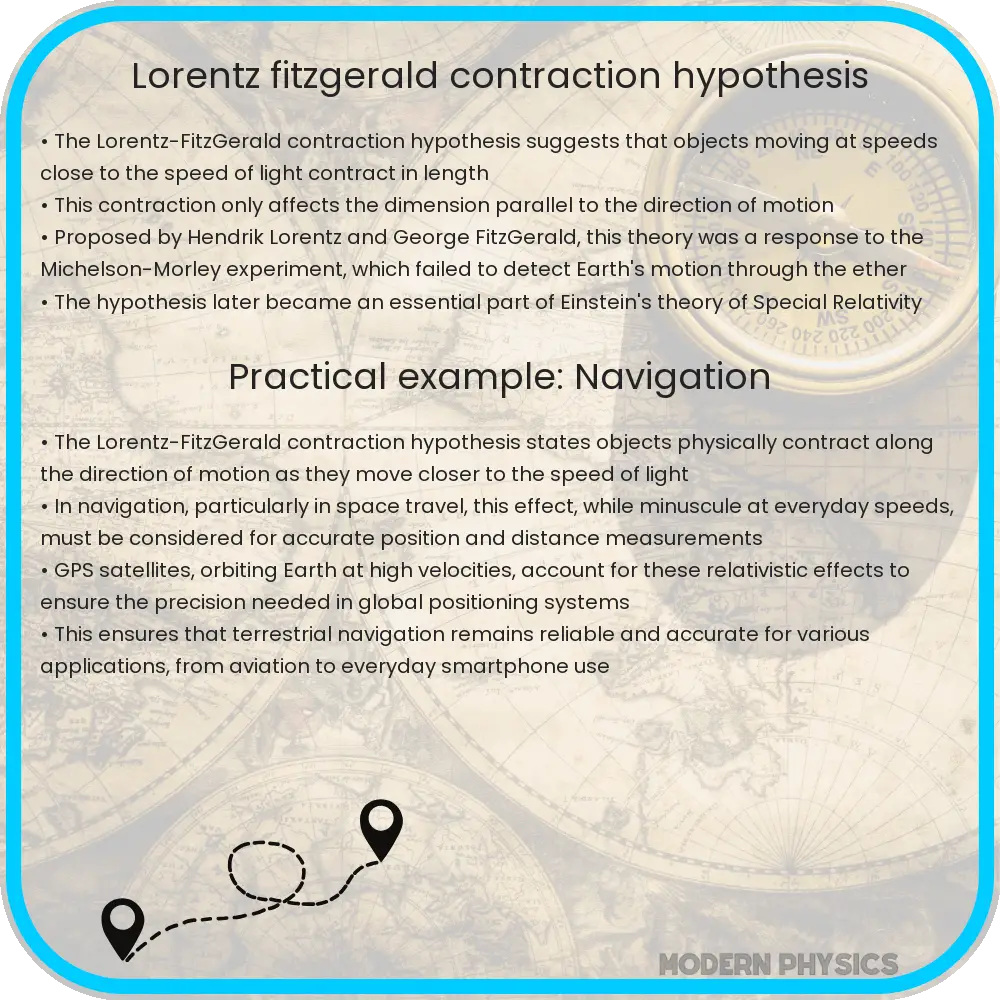Learn about the Lorentz-FitzGerald contraction, a key concept in special relativity describing how moving objects appear shorter from a stationary perspective.

Understanding the Lorentz-FitzGerald Contraction
The Lorentz-FitzGerald contraction, often simply referred to as Lorentz contraction, is a fundamental concept in the theory of special relativity. Introduced by Hendrik Lorentz and independently by George FitzGerald in the late 19th century, this phenomenon helps explain how objects in motion appear to contract in the direction of motion from the perspective of a stationary observer.
Theory of Special Relativity and Lorentz Contraction
Special relativity, proposed by Albert Einstein in 1905, revolutionized the way we understand space and time. Central to this theory is the idea that the speed of light in a vacuum is constant and absolute, irrespective of the motion of the observer. This assertion leads to various transformative insights, including time dilation and Lorentz contraction.
Lorentz contraction describes the effect that for an object moving at a significant fraction of the speed of light, its length appears shorter along the direction of motion when measured by a stationary observer. The mathematical expression for this contraction is given by:
L = L0 * sqrt(1 – v2 / c2)
Where:
- L is the length of the object as measured by a stationary observer.
- L0 is the proper length or the length of the object as measured in the rest frame of the object itself.
- v is the velocity of the object relative to the observer.
- c is the speed of light in a vacuum.
As velocity v approaches the speed of light c, the denominator approaches zero, making L significantly smaller than L0. This means that from the viewpoint of a stationary observer, fast-moving objects are observed to be much shorter in the direction of their motion compared to their length at rest.
Real-World Implications of Lorentz Contraction
While Lorentz contraction might sound purely theoretical, it has practical implications in modern physics and technology. For instance, it plays a crucial role in the field of particle physics. High-speed particles in accelerators, such as protons in the Large Hadron Collider, must be accounted for Lorentz contraction for precise calculations in experiments and in understanding their behavior at near-light speeds.
Moreover, this concept is critical in the Global Positioning System (GPS), where the accuracy of satellite signals depends on adjustments made for both the effects of General Relativity (gravitational time dilation) and Special Relativity (such as time dilation and Lorentz contraction). Without these corrections, there would be significant errors in positioning data provided by GPS, affecting everything from navigation systems to military operations.
Visualizing Lorentz Contraction
To visualize Lorentz contraction, imagine a fast-moving train. To an observer standing on the platform, the train appears shorter than its actual length when at rest. However, for passengers sitting on the train, everything appears normal, and the train’s length does not seem to have changed. This difference in perception illustrates how motion can affect the measurement of physical dimensions depending on the observer’s frame of reference.
Challenges and Common Misconceptions
Understanding Lorentz contraction can be counterintuitive and presents challenges in grasping the non-absoluteness of physical measurements—length, time, and simultaneity—that are otherwise considered constant in classical physics. Common misconceptions include the belief that objects physically contract, while in reality, contraction is a result of the measurement process influenced by relative motion between the observer and the object in question.
Furthermore, some might think that Lorentz contraction violates the principles of conservation, such as conservation of volume or mass. However, it’s important to recognize that such principles are not violated; rather, they are reinterpreted within the framework of relativity to apply locally — in the immediate vicinity of the object or phenomena being measured.
Conclusion
Lorentz contraction is more than just a peculiar outcome of mathematical equations; it is a real effect with tangible impacts on fields reaching from particle physics to our everyday use of GPS technology. By understanding concepts like Lorentz contraction, students and enthusiasts can better appreciate the intricate and beautiful nature of the universe as described by the theory of relativity. It encourages us to reconsider our preconceived notions of space and time, keying us into the realization that there may be far more to these fundamental elements than our everyday experiences would suggest.
Whether you are a physics student, a curious learner, or a professional in a related field, embracing these concepts opens up a broader spectrum of understanding and opportunities for innovation. The study of such phenomena reminds us that science is continually evolving and that each discovery, no matter how abstract, can contribute to substantial advancements in technology and our comprehension of the cosmos.
